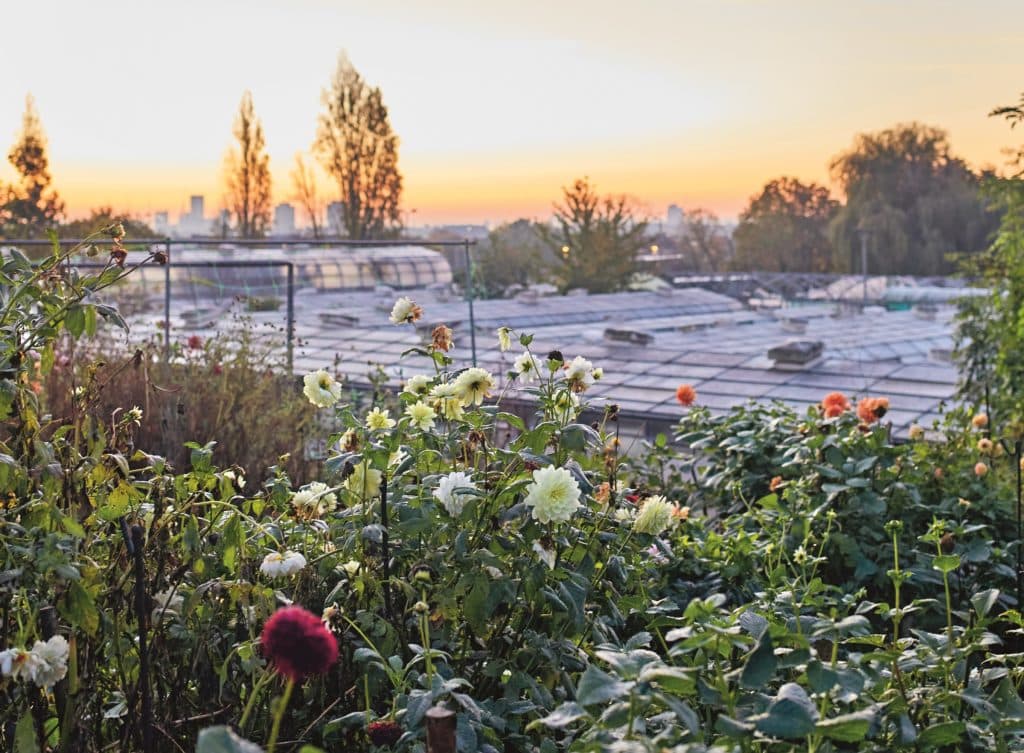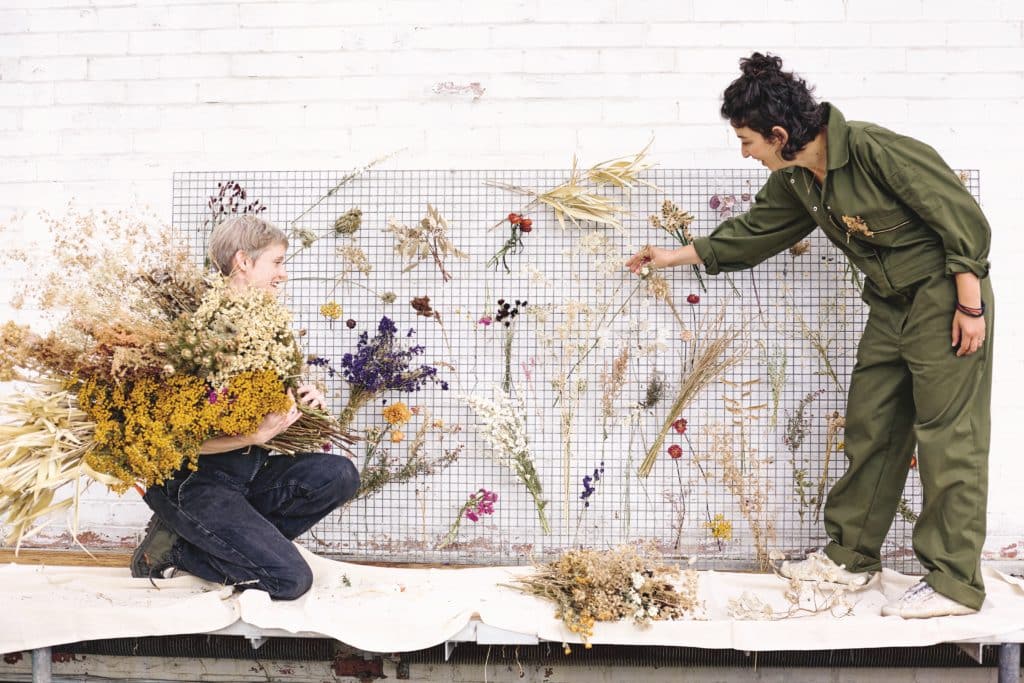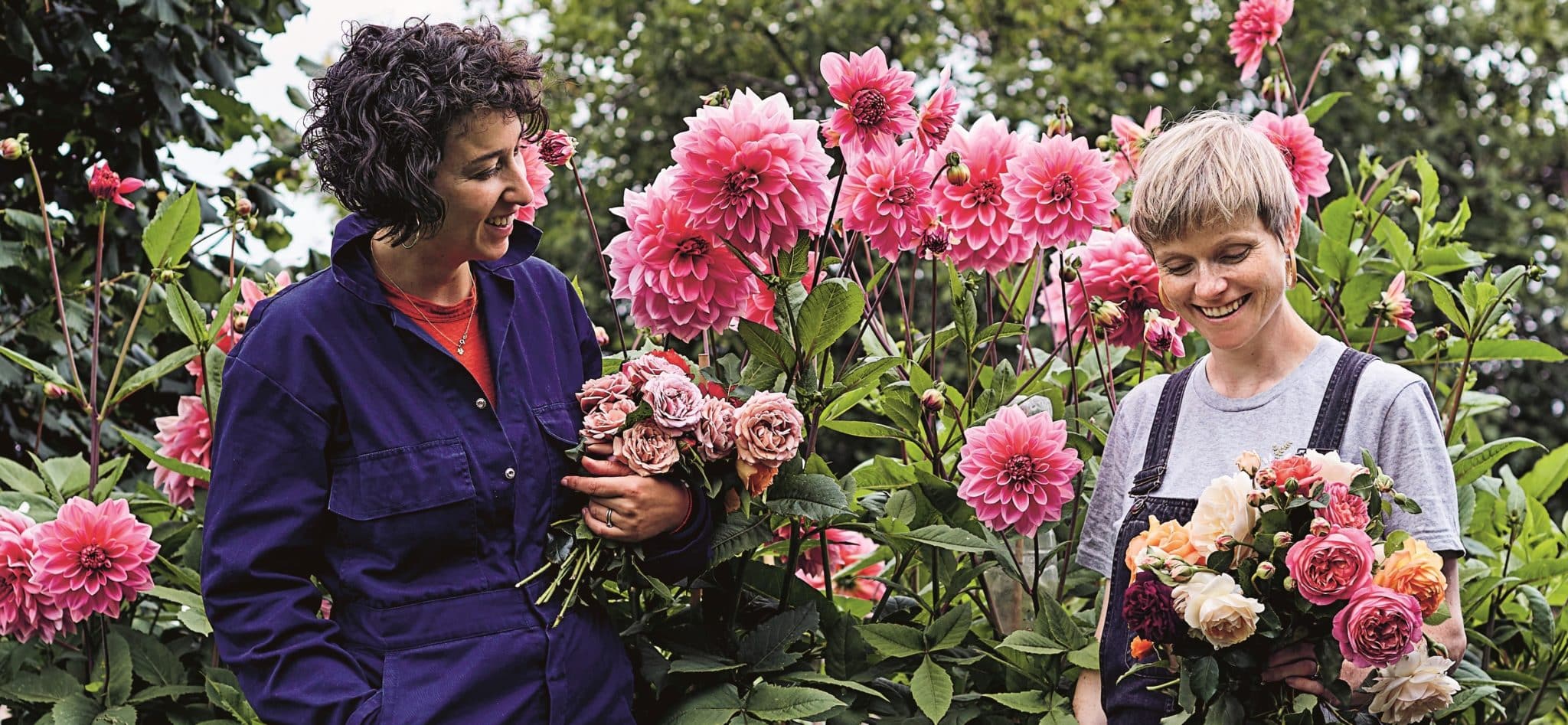Camila Romain and Marianne Mogendorff, the founders of Wolves Lane Flower Company, grow on a micro flower farm in north London among fig trees, the occasional bramble and in a 40m glasshouse. Part of a new wave of farmer/florists committed to spreading the word about seasonality, their flowers are seasonal, scented and never treated with chemicals or pesticides.
Like the food revolution that focuses on provenance, locality, climate, and sustainability, the pair want these same principles to apply to flowers. How To Grow The Flowers is their first book and is a practical, approachable guide to growing flowers for everyone.
Wicked Leeks (WL): Your book intro really sets out why flowers are more than just beauty – can you explain how you feel flower growing is part of a bigger picture?
Camila Romain and Marianne Mogendorff (CRMM): The majority of people now live in cities. There’s traffic, concrete, pressured to-do lists and it can be easy for people to become blind and inconvenienced by the natural world around them. Flower growing reopens our receptors to nature, to the elements that keep our planet healthy (good soil, rain, sun and clean air) and cultivates our appreciation of beauty. It teaches us the importance of delayed gratification – that it’ll take six months from bulb to vase to enjoy a tulip – and to feel part of the natural world. The more we appreciate our interconnectedness to the living things around us, the better caretakers of the planet we’re likely to be.
WL: Growing things for beauty is also hugely fulfilling. How far do you think joy and beauty, and on a wider level art and creativity, need to be part of the transition to a sustainable future?
CRMM: The act of growing beautiful things – whether that’s runner beans, dahlias or succulents – is an act of hope and belief for a positive future. In contrast to the fear, powerlessness and paralysis we may feel about the planet’s future, the joy we derive from the plants we grow is a powerful motivator to effect change. A window box of Calendula buzzing with pollinators and soil inhabited by earthworms and centipedes sparks joy and in turn motivates us to do more.
In contrast to the fear, powerlessness and paralysis we may feel about the planet’s future, the joy we derive from the plants we grow is a powerful motivator to effect change.
WL: What are the common obstacles or problems people face with growing flowers successfully?
CRMM: It’s important people are realistic about their own unique conditions for growing. How much space, sun and crucially time do you have? Plants grown from seed are like a micro maternity ward. They need a lot of attention so they don’t dry out, sit in soggy soil or get too leggy searching for the sun. Any adversity they face will check their overall health. If you’re short on time opt to grow something more resilient like a sedum [stonecrop]. You can grow it easily from cutting, it’s happy with dry conditions, the bees love it and it’s useful as both a cut and dried flower.
People also get very despondent about slugs and snails. We always advise cultivating a healthy, biodiverse environment within your garden to encourage natural predators to help you keep the slug population in check (a pond is ideal), to plant out seedlings once they’ve become healthy, sturdy plants (that can withstand a bit of nibbling) and to keep checking in on your plants so you’re able to help them to establish successfully.
WL: How important is good soil for flowers – is it true wildflowers are more tolerant of lower quality soil?
CRMM: Yes, true wildflowers do not want a nitrogen-rich soil but are happier on free-draining soil with low fertility, where they’ll have less competition from grass or other dominant weeds. However, while this advice may help you establish a wildflower meadow, healthy soil is paramount for an abundant garden. No matter how small your garden it’s possible and invaluable to have a composting system. Bays or daleks are good for larger spaces, while hotbins, wormeries or bokashi can work brilliantly for even the smallest plot. Soil is full of life and needs a constant source of organic matter to keep the millions of microorganisms living within it flourishing.

WL: Cut flowers are booming in popularity but often come from unsustainable sources – can you explain what you know of the mainstream flower supply chain?
CRMM: Over 80 per cent of cut flowers bought in the UK are grown abroad. As a consumer picking up a bunch in the supermarket, you’re given zero information about those flowers’ provenance. While this might not seem like a big deal, you might be unwittingly rubbing noses with a whole host of pesticides, fungicides or preservatives those flowers have been treated to as you try to catch their scent (chances are you won’t anyway as most supermarket flowers have had the fragrance bred out of them to enhance shelf life).
For such an ephemeral product that we can grow so successfully in our own climate, the cost to our planet is too great to fly flowers across the globe spouting out tonnes of carbon in the process.
Holland still dominates the flower industry, but countries from further afield such as Kenya, Ethiopia or Colombia also grow huge quantities of flowers and the conditions in which workers operate are often not well regulated. Are they given PPE to wear when dousing the crops in chemicals? Are they paid a fair wage and fairly treated? How are those chemicals affecting the biodiversity of the area they’re grown in when they get into the water source? For such an ephemeral product that we can grow so successfully in our own climate, the cost to our planet is too great to fly flowers across the globe spouting out tonnes of carbon in the process.
WL: How do you protect flowers from pests and aesthetic damage, without using chemicals?
CRMM: Prevention not treatment is our motto. Create a healthy, biodiverse environment for your plants from the off. If you can attract ladybirds into your garden, then the aphids won’t be able to overwhelm your plants. If your soil is healthy and full of organic matter, then the microorganisms within your soil will help you grow healthy plants. If you do experience an influx of a pest, whether that’s aphids, snails or rabbits, you have an imbalance in your ecosystem that needs addressing. There are always ways you can try and fight back against the pests, whether that’s strong fencing to keep the deer or rabbits out, buying in ladybird or lacewing larvae to eat your aphids, or mulching dahlias with sheep’s wool to deter slugs, but the real secret is to be two steps ahead of the problem.

Perhaps we’ve also all forgotten that flowers are a living thing and a little nibble hole or water speckle on the petals arguably makes that bloom more beautiful than its perfectly straight stemmed supermarket counterpart? Let’s celebrate flowers as living things with all their imperfections and wiggly stems!
WL: How does gender come into the history of flower growing? What do you think about the role of women in a sustainable future for food and farming?
CRMM: While flowers have historically been associated with the feminine, the flower industry is still dominated by men. It is a vast behemoth industry driven by profit at all cost to the environment and it’s a world where women are often at the bottom of the pecking order, be it in the African and South American countries where sexual harassment or no maternity rights for women have been widely reported, to the auction floors of Aalsmeer in Amsterdam (the world’s main distribution hub for flowers), where women are virtually non existent. While it is reductive and unhelpful to cast men as the villain, it is exciting to contemplate an alternative model of flower growing which works respectfully with nature and is driven by women in the UK. The appetite and expertise are there, but [we] need support and subsidy on an ambitious level to become a serious contender to the imported flower industry.
While flowers have historically been associated with the feminine, the flower industry is still dominated by men.
WL: Are you part of the wider Wolves Lane Centre community and how does your work fit alongside growing that takes into account accessibility and culturally appropriate food?
CRMM: We are the old hands at Wolves Lane having been there since OrganicLea acquired the lease in 2017. We’ve seen loads of different growers pass through, but each of them have been passionate about providing produce that enhances rather than harms the environment it’s grown in. Horticulture is still not a diverse sector, and the barriers both historical and current that prevent people of colour from pursuing it as a career are substantial. Wolves Lane is a space with more diversity than most growing spaces in the UK and is home to the brilliant Black Rootz, a collective of growers and educators of colour who are working to positively address issues relating to food justice and sovereignty.
WL: What are the easiest three flowers to start with?
CRMM: Start with easy hardy annuals from seed – cornflower was our first. It has a chunky seed, germinates readily and is a ‘cut and come again’ crop. There are thousands of dahlia varieties to choose from and are our summer essential flower. If you want to invest a bit more in your garden, find a rose to fall in love with. We love repeat flowerers like Lady of Shallot or Grace.
WL: Do you have any tips for designing a seasonal flower garden?
CRMM: Accept that designing a garden of any type is a slow process despite what all the makeover TV shows might lead us to believe. Be clear on how long you will have this garden in your care. If you’re in for the long haul, get your structure in using shrubs, trees and perennials such as Ribes, Crab Apples or Geums. They’ll take longer to establish but you’ll be grateful for them in years to come. Think next about bulbs and dahlias to provide interest at either end of the season and then consider how different annuals each year can provide interest and variety to your palette. Don’t overthink colour schemes and just grow what you love; that way you’ll be sure to look after the plants and won’t forget to water them.
How To Grow The Flowers: A sustainable approach to enjoying flowers through the seasons, by Camila Romain and Marianne Mogendorff, (£20, Harper Collins), is out now.









I have been given this book by Marianne’s very proud mother in law. My friend of over 60 years. The text and illustrations are wonderful, informative and a beacon of hope in a disrupted world. It’s an easy read too. Well recommended.